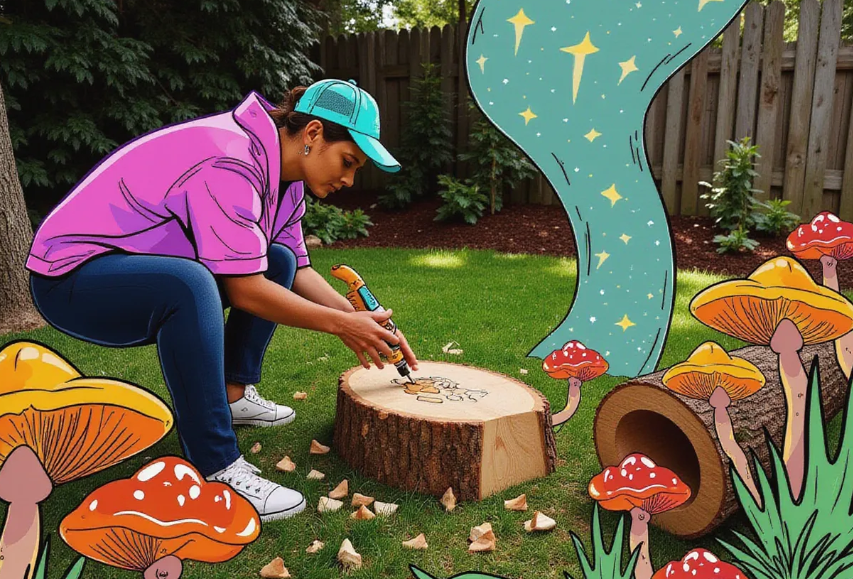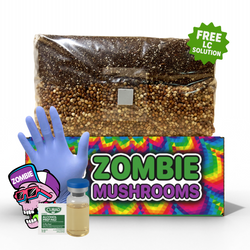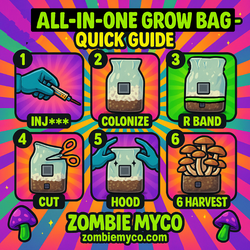⬇️ Prefer to listen instead? ⬇️
- Mushroom logs can grow mushrooms for up to 7 years with little work.
- Oak and maple trees are best for growing mushrooms on logs.
- The best time to put mushroom spores in logs is late winter to early spring for the best results.
- Keep logs moist and shaded during the 6–18 month growth time.
- Logs can grow mushrooms many times a year and do well when soaked in water for 24 hours to start mushroom growth.
For gardeners, DIY enthusiasts, or anyone who values natural, low-maintenance cultivation, growing mushrooms on logs at home is a rewarding method. Using logs outdoors connects your setup to nature while producing delicious mushrooms like Shiitake, Oyster, or Lion’s Mane with minimal daily work.
A big plus: tools like mushroom grow bags make inoculation easier by providing clean, vigorous spawn that transfers well into drilled hardwood logs. Whether you’re setting up your first log or managing a seasonal patch, this guide walks through the steps, wood selection, care, and harvest timing to help you get strong yields from log cultivation.
Let’s see how you can use simple hardwood logs to make a mushroom farm.

Why Grow Mushrooms on Logs?
Mushroom logs are a good way to grow mushrooms that is easy on the earth, takes little effort, and gives you lots of mushrooms. Unlike man-made or quick-to-use materials for growing indoors—like straw or sawdust—logs are like the wild places where many good and medicinal mushrooms grow. This is not only a very lasting way to grow, but it also often makes the mushrooms taste better and last longer after picking.
Here are some of the main good things
- Long-lasting: Logs can grow mushrooms for 3 to 7 years after they start.
- Little work: They don't need much work after you set them up, unlike growing in rooms.
- Low cost: After you start, it costs almost nothing to keep going.
- Good for nature: Using logs from trees that are cut or fall down helps use waste wood.
- Fits in nature: Mushroom logs can look good in a garden, woods, or natural-style landscape.
Growing mushrooms on logs outside is really good for people who like organic gardening, growing trees and crops together, or taking care of woods.

Best Mushroom Types to Grow on Logs
Not all mushrooms you can eat will grow well on logs, but many do well if you use the right kind of wood and growing conditions. Here are the best kinds to think about
Shiitake (Lentinula edodes)
The best mushroom to grow on logs. Shiitakes are very liked because of their strong, rich flavor and meaty feel. They grow best on strong hardwoods—mainly oak—and usually give you a good amount of mushrooms.
- Growth time: 6–18 months
- Mushroom seasons: Spring and fall (cool and wet)
- Log life: Up to 7 years
- Health benefits: Lots of polysaccharides and good for your immune system
Fun Fact: Shiitake mushrooms are one of the most grown log mushrooms in the U.S. [USDA, 1999]
Oyster Mushrooms (Pleurotus spp.)
Oysters grow fast and are easy to grow, good for beginners. They start growing quickly and make mushrooms in different temperatures and wood types. Types include Blue Oyster, Pink Oyster, and Golden Oyster, and they all need slightly different growing conditions.
- Growth time: As fast as 4–6 months
- Mushroom seasons: Many times a year, mostly in warm weather
- Log life: 2–4 years
- Best for: Getting mushrooms fast and trying different kinds
Lion’s Mane (Hericium erinaceus)
This strange and shaggy mushroom is known for its crab-like feel and said to help your brain. Lion’s Mane likes maple, beech, and other hardwoods that don't have too much tannin.
- Growth time: 6–12 months
- Mushroom seasons: Fall and spring
- Log life: ~3–5 years
- Cooking note: Great when cooked in butter, often used instead of seafood
Reishi (Ganoderma lucidum)
This one grows slowly and is known more for being medicine than food. Reishi mushrooms take time but grow into nice, shelf-like shapes and do well on strong woods.
- Growth time: Up to 18 months
- Mushroom seasons: Summer
- Log life: Up to 10 years
- Medicinal value: Has triterpenoids and other good things linked to immune health
Matching wood type with mushroom type is key. For example, Shiitake needs strong hardwood, while Oyster can grow on softer hardwoods like alder or even fruit trees like apple and cherry in some cases.

Choosing the Right Tree Logs
The wood you pick will directly change how many mushrooms you get, how healthy they are, and how well they grow. Here’s how to make sure you’re using the right logs
Best and Worst Wood for Mushroom Logs
-
Ideal Hardwood Choices:
Use dense hardwoods with high lignin and slow decay for long-lasting yields. Oak is top tier, followed by Maple, Beech, Alder, Birch, and Ash. Each supports different mushrooms well—Shiitake especially prefers oak; Lion’s Mane and Oyster tolerate slightly softer hardwoods. -
Avoid These Woods & Conditions:
Stay away from softwoods like pine, cedar, or spruce (resins can inhibit growth). Avoid wood that’s overly dried out or has begun rotting, and reject logs with visible mold, insect damage, or disease. Logs cut just before use (or stored briefly in shaded, moist places) retain more nutrients and moisture.
Best Log Size
- Width: 3–6 inches
- Length: 3–4 feet
- Weight: Should be easy for one person to move
Logs should still have their bark and be used within 1–2 months of being cut. Tree sap helps feed the mushroom growth, and the bark protects them while they are growing inside.

When to Put Spores in Logs
Putting spores in at the right time makes sure you have the best chance of success. Starting at the right time of year makes sure the logs are not too dry and helps the mushroom beat out wild fungus.
Best Time
- Late winter to early spring (February – April): Best time to put spores in for places with mild weather.
- Temperatures: Best between 40–70°F when putting spores in.
- Conditions: Logs should still be wet but not frozen.
Logs cut when the tree is not growing (late fall through early spring) have the most food and help stop bugs and bad fungus.
Tip
If you have to wait after cutting, keep logs in a shaded, wet place off the ground to keep water inside.

Tools & Things You Need
Before putting spores in, it’s important to get the right tools. The type of spores you pick—plug, sawdust, or grain—will change some of the tools you need.
Must-Have Supplies
- Hardwood logs (fresh-cut, bark still on)
-
Mushroom spores: You can get them as:
- Plug spores (small wood pieces with mushroom growth already in them)
- Sawdust spores (needs a special tool to put them in)
- Grain spores (usually used for growing indoors)
Tools
-
Drill & drill bits
- 5/16" bit for plug spores
- 7/16" for sawdust spore tools
- Mallet or hammer (for plug spores)
- Sawdust spore tool (called a palm inoculator)
- Wax: Cheese wax or beeswax; used to close holes after putting spores in
- Brush or dauber: For putting on melted wax
- Place to put logs: Bricks, pallets, or blocks to keep logs off the ground
Good to have but not needed
- Shade cloth or tarp: Good in hot, dry places
- Big tub or kiddie pool: For soaking logs to start mushroom growth
How to Inoculate Logs & Care for Them
After putting spores in, logs go through an important growing time. Here’s what will happen and how to help it along.
-
Clean and Get Logs Ready
Make sure logs are clean of dirt, mold, and rot you can see. Keep them wet but not too wet. -
Drill Holes for Spores
- Make holes 6 inches apart in rows, rows 2 inches apart, in a pattern along the log.
- Drill holes about 1 to 1.5 inches deep, depending on spore type.
-
Put Spores In
- Put in plug spores and tap them in with a mallet until they are even with the wood.
- For sawdust spores, use the tool to push and put spores into holes.
-
Close with Wax
- Melt wax and put it over each hole with a dauber or brush.
- Also wax any cut or broken ends to stop water loss.
-
Stack Logs
Put logs in a shaded, safe place with good air flow.- Stack them well: lean them against something or stack them like a "log cabin".

Growing and Mushroom Conditions
-
Log Prep: Use fresh hardwood cut within last 1-2 months. Keep bark intact. Soak the log if it's dry, but avoid waterlogging.
-
Drilling & Spore/Spawn Insertion: Drill holes spaced approximately every 6–8 inches along log, in staggered rows. Tap plug spawn or sawdust spawn into holes.
-
Sealing & Placement: Seal each hole (and any cut ends) with melted wax to retain moisture and block out contaminants. Place logs off the ground on pallets or bricks under partial shade with good airflow.
-
Growth & Fruiting Conditions: Maintain shade (~80%), regular moisture (logs should feel damp), and soak when needed especially in dry seasons. Growth timeline varies by species—Oysters may fruit in 4-6 months; Shiitake often takes 9-18 months.

Picking Mushrooms from Logs
Picking mushrooms at the right time is key for best taste and future mushroom crops. Look for mushrooms with caps that are open fully.
How to Pick
- Twist or cut mushrooms cleanly at the bottom of the stem.
- Use a sharp knife; don’t tear or hurt the mushroom growth in the log.
- Pick mushrooms many times a year depending on rain, temperature, and mushroom type.
It’s important to keep picked mushrooms in a paper bag in the fridge for best freshness. Don't put mushrooms in plastic bags because they need to breathe and can get soggy.

Keeping and Taking Care of Logs
Keeping your mushroom logs growing mushrooms for a long time just takes a little bit of easy work.
Care Tips
- Keep logs off the ground on bricks or pallets to stop bad things from the soil.
- Turn logs sometimes to make sure they get wet evenly.
- During mushroom seasons, soak every 8–10 weeks to start mushroom growth again.
- Remove moldy spots and slugs.
- Keep up shade and wetness for as long as you use the logs.

Common Mistakes to Avoid
Don't make these common mistakes to make sure your mushroom logs stay healthy and grow well
- Using softwood like pine
- Putting spores in logs more than 2 months after cutting
- Not using wax to close holes, which can bring bad things in
- Stacking in full sun or very dry places
- Thinking all logs will grow mushrooms very fast—some need up to 18 months

Mushroom Grow Kits vs. Logs
Both are good in different ways. Here’s how they are different:
| Feature | Grow Kits | Mushroom Logs |
|---|---|---|
| Start Time | 15–30 minutes | 1–2 hours |
| Mushroom Time | 10–21 days | 6–18 months |
| Life | 2–3 crops over 1–2 months | 3–7 years of mushroom crops |
| Care | Medium (indoors, misting every day) | Easy (checks every week/month) |
| Cost | Low to medium | Cheap over time |
Both ways work for growers with different wants—fast mushrooms vs. long-term growing. Using both lets you grow your own good mushrooms all year.

Special Deal: Save Now on Mushroom Grow Kits
Zombie Mushrooms is now giving special discounts on their indoor grow kits—good for growers who don't want to wait or who can't grow outside all year. These same mushroom types are also sold as spores, packaged for putting in outdoor logs. Use this chance to start inside and change to longer-lasting log ways outside.
FAQ
-
How long before mushrooms start to appear on logs?
Depending on species: Oyster logs may fruit in ~4-6 months; Shiitake could take 9-18 months. -
What diameter and length are best for logs?
Logs 3-6″ in diameter and 3-4 feet long are ideal—manageable, yet large enough to hold moisture and nutrients. -
Do I need to soak logs before use or between flushes?
Yes. Soaking freshly cut logs or soaked when dry seasons hit boosts fruiting; logs should be refreshed with moisture about every 8-10 weeks during growth seasons. -
Can grow bags be used with logs?
Yes. Using mushroom grow bags for spawn preparation helps ensure clean, vigorous inoculant. You can also use bags to incubate spawn before transferring to logs. -
How to harvest mushrooms from logs properly?
Harvest when caps are mature but not overly open. Twist or cut carefully at the base—don’t tear. Store fresh mushrooms in paper bags in fridge; avoid plastic to prevent moisture build-up.
Last Tips & Encouragement
Growing mushrooms on logs is not just a way to grow fresh, healthy food—it’s a fun, long-term relationship with nature. As each season goes by, your logs will give back, giving you tasty mushrooms with just a little work. Time, the right tools, and good care are what you need; if you do these things, mushrooms will do the rest.
Whether you're adding mushrooms to a food forest, trying it in your yard, or wanting to grow food for a long time with little harm to nature, mushroom logs are a great thing to have in your garden.
Citations
- Stamets, P. (2000). Growing Good and Medicinal Mushrooms (3rd ed.). Ten Speed Press.
- Bayer, E., & Panozzo, J. (2019). Easy Mushroom Farming. Fungi Ally Publications.



